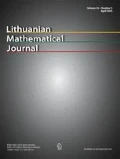Abstract
We study the structure of solutions of Kesten’s equation (1.5), where a, b ⩾ 0 are the coefficients of the GARCH(1,1) process in (1.1). We prove that, for any b ∈ (0, 1) and any κ > 0 small enough, there exists a stationary GARCH(1,1) process with tail index κ.
Similar content being viewed by others
References
B. Basrak, R. A. Davis< and T. Mikosch, Regular variation of GARCH processes, Stochastic Process. Appl., 99, 95–116 (2002).
P. Bougerol and N. Picard, Stationarity of GARCH processes and of some nonnegative time series, J. Econometrics, 52, 115–127 (1992).
T. Bollerslev, Generalized autoregressive conditional heteroskedasticity, J. Econometrics, 31, 307–327 (1986).
T. Bollerslev, R. Y. Chou, and K. F. Kroner, ARCH modeling in finance: a review of the theory and empirical evidence, J. Econometrics, 52, 5–59 (1992).
T. Bollerslev, R. F. Engle, and D. B. Nelson, ARCH models, in: R. F. Engle and D. L. McFadden (Eds.), Handbook of Econometrics, vol. 4, Elsevier Science, New York (1994), pp. 2961–3031.
R. A. Davis and T. Mikosch, Extreme value theory for GARCH processes, Preprint (2007).
P. Embrechts, T. Mikosch, and C. Klüppelberg, Modelling Extremal Events: for Insurance and Finance, Springer, London (1997).
R. F. Engle, Autoregressive conditional heteroscedasticity with estimates of the variance of United Kingdom inflation, Econometrica, 50, 987–1008 (1982).
L. Giraitis, R. Leipus, and D. Surgailis, Recent advances in ARCH modelling, in: G. Teyssière and A. P. Kirman (Eds.), Long Memory in Economics, Springer, Berlin (2007), pp. 3–38.
L. Giraitis, R. Leipus, and D. Surgailis, ARCH(∞) models and long memory properties, Preprint (2007).
C. M. Goldie, Implicit renewal theory and tails of solutions of random equations, Ann. Appl. Probab., 1, 126–166 (1991).
C. M. Goldie and R. Grübel, Perpetuities with thin tails, Adv. Appl. Probab., 28, 463–480 (1996).
I. S. Gradshteyn and I. M. Ryzhik, Table of Integrals, Series and Products, Academic Press, Orlando (1980).
H. Kesten, Random difference equations and renewal theory for products of random matrices, Acta Math., 131, 207–248 (1973).
Ji-Chun Liu, On the tail behaviors of a family of GARCH processes, Econometric Theory, 22, 852–862 (2006).
T. Mikosch and C. Stărică, Limit theory for the sample autocorrelations and extremes of a GARCH(1,1) process, Ann. Statist., 28, 1427–1451 (2000).
D. B. Nelson, Stationarity and persistence in the GARCH(1,1) model, Econometric Theory, 6, 318–334 (1990).
A. P. Prudnikov, Y. A. Brychkov, and O. I. Marichev, Integrals and Series: Elementary Functions, vol. I, Gordon and Breach Science Publishers, New York (1986).
T. Teräsvirta, Two stylized facts and the GARCH(1,1) model, in: Stockholm School of Economics, SSE/EFI Working Paper Series in Economics and Finance, vol. 96 (1996).
T. Teräsvirta, An introduction to univariate GARCH models, Preprint (2007).
Author information
Authors and Affiliations
Additional information
The research was partially supported by the bilateral France-Lithuania scientific project Gilibert and the Lithuanian State Science and Studies Foundation, grant no. T-15/07.
Published in Lietuvos Matematikos Rinkinys, Vol. 47, No. 2, pp. 196–210, April–June, 2007.
Rights and permissions
About this article
Cite this article
Klivečka, A., Surgailis, D. Garch(1,1) process can have arbitrarily heavy power tails. Lith Math J 47, 164–175 (2007). https://doi.org/10.1007/s10986-007-0012-z
Received:
Issue Date:
DOI: https://doi.org/10.1007/s10986-007-0012-z


